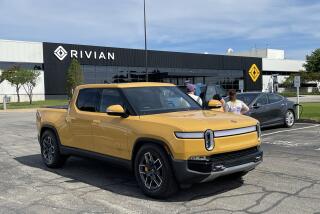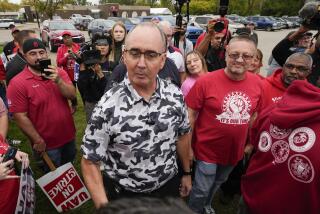Ford Cutbacks Spare Luxury Auto Group
As Ford Motor Co. carries out a massive restructuring that involves shuttering plants, cutting production, eliminating products and slashing 35,000 jobs from its payroll, the bloodletting will affect the Ford family around the world--except, it seems, in Southern California.
If Ford has a sacred cow, it is its Premier Automotive Group, whose North American headquarters was moved to Irvine late last year and whose London-based president, former BMW executive Wolfgang Reitzle, has seen his empire swell even as Ford Chairman William Clay Ford Jr. was drafting his corporate downsizing plan. Reitzle, in fact, has the chairmanâs blessing to expand PAG aggressively even as other Ford units are contracting.
The strategy makes sense to most industry analysts, who point out that the premier groupâs vehicles--from Aston Martin Lagondaâs hand-built $228,000 Vanquish at the high end to Volvoâs safe-and-sane sedans--are among the most profitable in Fordâs stable. Moreover, the luxury and performance car markets typically are among the last to feel the pinch of a weakening economy--and are among the first to reap the rewards of a recovery.
Thus, though the Ford and Mercury brands probably will see their market share shrink again this year, the PAG marques--with the exception of a rebuilding Lincoln--are expected to grow.
âPAG is the least problematic part of Ford,â said analyst Rod Lache of Deutsche Banc Alex. Brown. âThe luxury end of the market has the highest return, so it makes sense to pursue growth in that area.â
Ford earns an estimated $5,500 a vehicle from its luxury lines, about the same as it makes on big pickup trucks and sport-utility vehicles but double the profit on mainstream cars. The company has said it intends to push its worldwide luxury vehicle sales to 1.2 million units a year by 2006, up from about 850,000 last year.
With the exception of the loss of one model at Lincoln, PAG was conspicuously absent as Bill Ford--as he prefers to be called--ran down his hit list Jan. 11. Even elimination of the Continental model from Lincolnâs lineup is not a blow to the group. In fact, Fordâs domestic luxury brand is adding models, undergoing a brand redesign and probably will resurrect the Continental in a few years as a new flagship model.
Vic Doolan, president of PAGâs North American operations, noted that Lincoln will get a new small SUV called the Aviator this year and that each of its remaining models, including the Navigator SUV and the Town Car sedan, has been redesigned for the 2002 model year.
Even Mercury--which is part of Irvine-based Lincoln Mercury but not part of PAG--is faring well in its association with the premier brands. Though two of Mercuryâs models will be eliminated as part of Fordâs recovery plan--the slow-selling Cougar sports coupe and the aging Villager minivan--the brand is getting a new van and a new performance model called the Marauder.
Mercury insiders said the marque remains a moneymaker for Ford, and Bill Ford, Doolan and Brian Kelley, president of the Lincoln Mercury unit, all have said publicly in recent weeks that Mercury will stay.
For one thing, Ford could never make up with Ford models alone the sales it would lose by eliminating Mercury.
Mercury dealers sell 115,000 units of the full-size Grand Marquis sedan a year, 105,000 mid-size Sables and 45,000 Mountaineer SUVs, said Jim Hall, Detroit-based auto industry analyst for AutoPacific Inc. With virtually no advertising outlay on Mercuryâs part, the Grand Marquis, popular with older male buyers, regularly outsells its twin, the Ford Crown Victoria.
*
PAG Workers in Good Spirits
So while faces are long at Fordâs world headquarters in Dearborn, Mich., and at manufacturing plants around the globe, the mood among PAG and Lincoln Mercury employees, including about 1,000 at the Irvine complex, has been fairly cheerful--insiders describe it as relaxed and relieved. In all, Ford has about 1,300 employees in California, most in Irvine and at its Western regional office in Anaheim.
Plans for PAG call for introduction of 25 major new or redesigned models during the next five years. The groupâs five marques--Aston Martin, Jaguar, Land Rover, Lincoln and Volvo--accounted for about 18% of Ford Motor profit in 2000 but are expected to contribute a third by 2006, said Nick Scheele, the auto makerâs chief operating officer.
One reason the corporate parent considers PAG to be untouchable despite disappointing U.S. sales from several of its brands last year--Lincoln was down 17% and Volvoâs car sales dropped 12.8%--is that acquiring and beefing up the Eurocentric collection in the past decade represents an expenditure of about $15 billion. The company isnât going to win points with investors for junking that kind of investment.
âThe reason they spent that kind of money is so they can be strong in the upper-crust vehicle segment, where they expect a lot of sales growth to be in the next few years,â said David Cole, president of the Center for Automotive Research at the Altarum Institute think tank in Michigan.
Additionally, Bill Ford, who sacked Chief Executive Jacques Nasser and took over his duties in October, was instrumental in forming PAG three years ago and in hiring Reitzle to run it.
*
Groupâs Chief Says Problems Remain
In an interview before Ford released his recovery plan, Reitzle--a dapper Bavarian whose passions include cars and skiing and who previously ran BMWâs product development and marketing units--said he was not worried that Nasser, his chief mentor at Ford, was gone and that a corporate overhaul was coming.
âPAG is such a convincing strategy, and I know from Bill Ford that they are 100% fully supportive of the strategy,â Reitzle said. âWe have enough problems in other areas [of the company], so why create new problems where we have something which works?â
Reitzle is a engineer who waxes poetic when he discusses automobiles--âthe car has to be like an animal ... almost as if itâs aliveâ is an oft-repeated dictum. He acknowledges, though, that PAG must overcome problems.
Land Roverâs trucks regularly finish near the bottom of the barrel in quality and customer satisfaction surveys; Volvo, despite its reputation for safety, has quality problems as well; and Lincoln is hurrying to change its entire image lest it die out along with its customer base of over-60 males.
Reitzle has drawn some criticism from within Ford for insisting on keeping his headquarters in a London townhouse and surrounding himself with a group of senior executives--many of them former teammates at BMW.
But he also is seen as a consummate product planner, an executive who not only knows how to run a business but understands car design.
Reitzle said that he is about more than spending money--that organizing the premier brands into a centrally managed group will realize tremendous savings by enabling him to consolidate support services such as marketing, administration and engineering.
He also wants to stretch the use of common components so that Jaguars can share platforms with Volvos and Fords or use Ford and Lincoln components under the skin where they are unseen and make no difference in the distinctive characteristics of the individual brand. A single type of door-lock mechanism or light dimmer switch might migrate from Ford to Jaguar to Land Rover, but each brand would keep its own proprietary suspension springs and shock absorber design to ensure unique handling characteristics.
But job one, Reitzle said, is to improve quality at the factories.
âWhen you look at where we are at the moment, on J.D. Power quality surveys with Land Rover, for instance, then you know we are at the bottom,â he said. âAnd we want to move up, so that has to be changed.â
Land Rover sales, boosted by the late-year introduction in the U.S. of the $26,000 Freelander, held steady in 2001. Reitzle said plans call for sales to be propped up this year with a new high-end Range Rover model, designed and built under new quality standards and set to roll into dealerships this summer.
Jaguar, which Ford acquired in 1991 and has spent considerable time and effort improving, âis already nicely positioned,â Reitzle said. The brandâs U.S. sales rose 1.8% last year, and the addition late in the year of the X-Type, a so-called baby Jaguar priced to start at less than $30,000, is expected to keep sales pumped up this year.
The Aston Martin brand is a super-premier marque with just 1,500 sales worldwide last year--300 in the U.S. But the company had sold the first two yearsâ production of the V-12 Vanquish before the first one rolled out of the factory, and the brand intends to quadruple U.S. and worldwide sales over the next five years with its $150,000 Vantage models and a new small model to be priced about $100,000 to compete with the Porsche 911.






